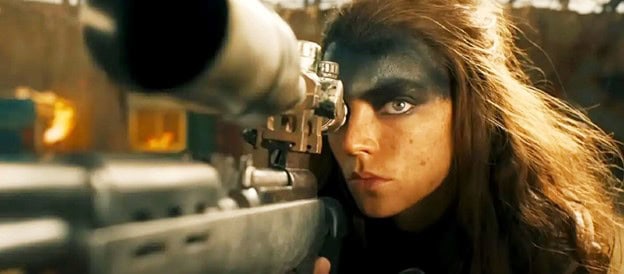By Andrew Jenck
Each of the Mad Max entries, all directed by George Miller, are distinct as to show a different side of the world but still in the same chaotic spirit. It’s akin to a composer’s symphony comprised of different tempo and octave while keeping the same melody. Furiosa: A Mad Max Saga is no different in its differences, serving a prequel to the acclaimed Mad Max: Fury Road yet a different beast together. Capturing lightning in a bottle twice rarely yields results; Miller opts instead for thunder, creating tension, atmosphere and character action as a lead up to the storm of Fury Road yet still holding a standalone narrative. More methodical and gradual yet maintaining the madness of its predecessor, Furiosa is a narrative epic crafted in rich, visual storytelling.
Some may take issue with the pacing, expecting the instant rush of Fury Road, rather than a slower burn of the first act. An approach, although different, parallels the previous picture by being richly detailed. The opening sequence not only establishes Furiosa as a clever and observant fighter but additionally sets the audience to be attentive as well. Centering a character in frame, one can see them minding their surroundings and the impending result of their actions. Cinematography calls attention to characters’ action, strategy, and methods of survival, sets audience expectation for the set pieces presentation.
Action scenes contain the same precision and brutality, albeit less chaotic and more methodical. Emphasis less on speed, more deliberation. A pattern of observe-act-result is present throughout, structuring the piece accessibly, never feeling repetitive. Workings of vehicles and fighting styles are relayed to the audience clearly, simultaneously personifying the main characters. Furiosa’s ingenuity and adaptability are contrasted with her partner Jack’s composure and stability; they’re compatible. Frame rate is at 48 adding flexibility to speed of which the action occurs: slowing to show the character’s actions and speeding to add intensity (Indiewire). As Andrew Jacks, VFX supervisor, describes, the film wasn’t fixed in post, but constructed and enhanced with visual effects, providing the audience comprehensive yet clear shots.
Too often modern action films frame the camera at a distance, obscuring the actor’s faces when the CGI doubles are on screen. Spectacle, here, is fueled by the actors’ performance, as Miller directs his actors to be observant and quick sighted amidst the chaos. Anya Taylor-Joy fills in for Charlize Theron flawlessly, channeling the original’s determination but in a more raw, unrefined way to be found in a teenager or young adult. Her child counterpart, Ayla Brown, holds her own for an extensive period of screen time that the transition from her to Taylor-Joy is seamless. Chris Hemsworth doesn’t overcook, as other claimed, but utilizing his comedic strengths to portray a charismatic villain balancing between threateningly quick-witted and incompetently pathetic. Performances are woven in harmony with the action to create a complete picture.
Furiosa isn’t as groundbreaking of a film as its nearly decades old predecessor is, but it is a great accomplishment, channeling the same spirit in a more deliberate, gradual manner. Action may not be consistently present yet remains striking and creative. Performances and choreography are in unison in front of meticulously planning and effect composition to create a film both accessible and revealing detain upon further viewings. So many mainstream films put emphasis on the spectacle, but Furiosa is one of the few where the story is enhanced by the spectacle.


.png)